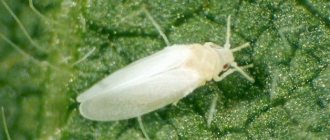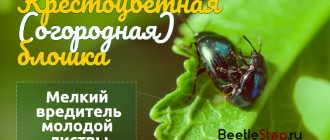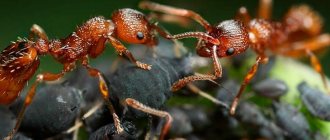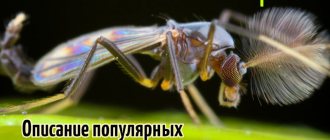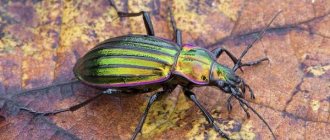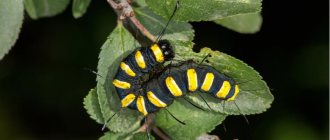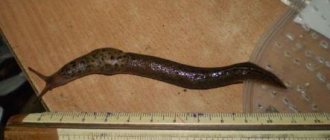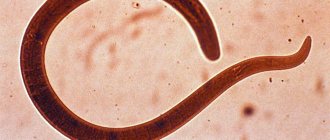The Colorado potato beetle is one of the most dangerous and harmful pests of tomatoes and other representatives of nightshade crops. The appearance of this insect in the garden is fraught with large-scale crop losses, because it is extremely voracious, fertile and able to quickly adapt to any environmental conditions. The fight against Colorado potato beetles on tomatoes is a complex and labor-intensive process, which is carried out using folk remedies, chemicals and effective agricultural practices.
Why is the pest dangerous?
The Colorado potato beetle is rightfully considered one of the most dangerous pests of vegetable crops. Adult beetles and their larvae feed on the above-ground parts of tomatoes and other nightshade crops, leaving behind only gnawed stems.
The fight against Colorado potato beetles is long and labor-intensive, since this pest is capable of traveling long distances. When it hits a garden bed, it easily flies to healthy plants. A colony of striped insects can completely destroy a future tomato crop in just 2-3 weeks.
The main danger of the Colorado potato beetle, which appeared in tomato beds, is its vitality, gluttony and ability to quickly adapt to any climatic conditions.
Even when treating an area with chemicals, it is recommended to change them periodically, since the insect develops immunity to the active components of insecticides.
What harm can aphids cause to tomatoes?
Aphids are small (up to 1 mm in length) insects with a pear-shaped body that parasitize not only tomatoes, but also other vegetable crops. It has an elongated proboscis with which it pierces the foliage. The bug sucks juice and nutrients from the cells, as a result the plant begins to dry out and then dies altogether.
The pest settles on the lower part of the leaf, forming entire colonies. Its eggs and larvae are able to safely wait out the winter period in the ground, in fallen leaves. With the arrival of spring, the parasite begins to actively reproduce.
The harm that bugs cause to tomatoes is that:
- plants become depleted, lag behind in growth and development;
- leaves are deformed and curled, the process of photosynthesis is disrupted;
- the crop has an increased risk of being affected by viral and fungal diseases (tomato mosaic, late blight, powdery mildew).
Important!
If the fruits are already fully formed before the insects appear, then the aphids will not harm them. Otherwise, if the infection occurs at the stage of active formation of the ovary, very few tomatoes are formed, they grow poorly and are deformed.
Signs of defeat
Identifying the Colorado potato beetle in tomato beds is not particularly difficult, since immediately after appearing in the garden it begins active “activity”. Pests can be identified by characteristic damage, which most often appears along the edges of leaf blades.
The larvae of Colorado potato beetles eat leaves from the edges to the center, so the presence of the pest is primarily indicated by the gnawed edges of the leaf blades. With extensive damage, they completely destroy all the tops.
Carefully inspect the above-ground part of the tomato bushes, paying special attention to the underside of the leaves. On them you can find a large number of orange eggs, tightly attached to each other.
How to get rid of beetles on tomatoes
To effectively combat Colorado potato beetles on tomatoes, it is necessary to use an integrated approach that combines folk remedies with industrial preparations and agrotechnical methods of control.
The use of folk remedies can bring a positive result only in the initial stages of damage to the area, with a small number of Colorado potato beetles and their larvae. In case of extensive colonies of pests, insecticidal preparations will bring a visible effect. But the treatment must be carried out several times, using different chemicals, since insects quickly develop resistance to their active ingredients.
Folk remedies
Folk remedies are used by many summer residents both to combat Colorado potato beetles and to prevent their appearance in tomato beds. Such products are prepared from natural and accessible ingredients that do not pose any harm to tomatoes and the future harvest.
Traditional recipes bring results only in the initial stages of damage to a garden bed; when there are a large number of pests, they are most often ineffective.
Popular folk remedies for Colorado beetles:
- Onion Peels – Place onion skins in a bucket until it is half full. Pour boiling water over the mixture and leave to steep for 24 hours. Then strain the onion infusion and dilute it with clean water in a ratio of 1:2 and use it to spray tomato bushes. Onion peels can be used to fertilize the soil in early spring. Colorado beetles cannot stand its smell.
- Bird droppings are an effective folk remedy for controlling Colorado potato beetles in tomato beds. To prepare the solution you will need 20 g of chicken manure and 5 liters of clean water. Use for watering plants.
- Laundry soap - grate a bar of soap, add 100 g of ground red pepper and pour 10 liters of water into this mixture. Mix well and spray the affected plants.
- Garlic - chop the garlic heads along with the arrows, then fill a glass of the resulting raw material with a bucket of water. Let the infusion ferment for 24 hours, then pour in 2-3 tablespoons of liquid soap and spray the tomato bushes.
- Wormwood - the essential oil contained in this plant is toxic to Colorado potato beetles. Chop the stems and leaves of wormwood, then mix a glass of the resulting raw material with the same amount of wood ash. Fill with hot water and leave for 4-5 hours to infuse. Use the strained infusion to spray tomatoes.
- Tobacco – 300 g of tobacco, pour 5 liters of water, leave to infuse for 24 hours. Spray the tomatoes with this infusion.
- Poplar leaves - pour the raw material into a bucket, filling it halfway, add boiling water to the very top, boil and leave to steep for 3 days. Spray the prepared infusion on plants affected by Colorado potato beetles.
- Copper sulfate - pour 100 g of copper sulfate into a bucket of water, mix and use to treat vegetable crops.
- Mustard - pour 100 g of dry mustard powder into a bucket of water, pour in ½ cup of table vinegar and add a bar of grated laundry soap. Mix well until the soap is completely dissolved and spray the tomatoes with this solution.
- Juniper – finely chop the young shoots of juniper, then pour 0.5 kg of the resulting raw material into a bucket of boiling water and leave to steep for 24 hours. Spray the tomato bushes with the strained solution.
To destroy Colorado potato beetles on young seedlings or adult tomato bushes, you can use urea . Dissolve 100 g of urea in 10 liters of water and water the young tomato seedlings. This product will not only help get rid of Colorado potato beetles, but will also additionally feed the plants with nitrogen.
Industrial products
In the fight against Colorado potato beetles, industrial preparations are indispensable, allowing you to get rid of both adult insects and their larvae.
Insecticides must be used exactly according to the instructions. The working solution is prepared according to the proportions specified by the manufacturer. You cannot increase the proportions, otherwise you can cause serious harm to the tomatoes.
Effective industrial preparations against Colorado potato beetles:
- Commander is a popular insecticidal drug used to combat Colorado potato beetles and other pests of vegetable crops. The product effectively destroys both adults and their larvae. Commander can be used in two ways - sprayed on plants or applied to the ground. For 5 liters of water you will need only 1 ml of the drug.
- Bombardir is an insecticidal preparation produced in powder form. Quickly destroys adult tomato pests and their larvae. To prepare the solution, pour 1 g of powder into a bucket of water and use for spraying according to the instructions.
- Bankol is a product in powder form for controlling garden pests. The drug is used very economically - for 10 liters of water you will need no more than 5 g of Bankol.
- Karate - insecticidal solution is prepared according to the manufacturer's instructions. To treat tomatoes, you need to dissolve 1 ml of the drug in 10 liters of water. The death of pests occurs within a few hours after spraying tomatoes.
- Aktara is one of the most popular and effective insecticidal preparations, effective against a wide range of insect pests. The product is available in the form of 1.4 g sachets. To spray tomatoes, use a solution of 10 liters of water and a sachet of Aktara.
- Inta-Vir is a common insecticide in tablet form. Dissolve 1 tablet in a bucket of water and spray the tomato beds.
- Calypso is a broad-spectrum drug that can be used for both adult plants and seedlings. Dissolve the insecticide ampoule in a glass of water, mix well and pour the solution into a bucket of clean water. Spray beds of tomatoes and other vegetable crops where Colorado potato beetles have been spotted.
- Fas is a new insecticide for controlling a wide range of garden pests. Dissolve 2 tablets of the drug in a bucket of water and treat the tomatoes in the garden.
- Karbofos is a popular insectoacaricidal agent with enteric contact action, effective against most known insect pests. For the working solution, use an ampoule of Karbofos and 5 liters of water. Spraying should be carried out according to the manufacturer's instructions.
- Decis is a fast-acting drug that is resistant to weather conditions and precipitation. To treat tomatoes, use a solution of 1.5 ml of product per 10 liters of water.
Treatment of tomato beds with insecticidal preparations should be carried out only in the early morning or late evening. Do not spray plants during the day, as the sun's rays will cause burns to wet foliage.
Peculiarities of life and reproduction of Colorado beetles
For the winter, adult beetles burrow into the soil beyond the freezing point (70 cm and deeper). Part of the reserve of adult beetles remains in the ground for 2-3 years. In the spring, when stable warm weather sets in and the air temperature rises to +15°C, adult individuals come to the surface. This is approximately the period of mass flowering of dandelions, active growth of weeds from the nightshade family (black and red nightshade, datura, belladonna, henbane).
Greedily eating the young leaves of desired weeds, the beetles later fly from old eaten plants to young plantings of tomatoes, eggplant, and potato tops. Here, on the underside of 1-2 tiers of leaves of cultivated crops, the female lays eggs in groups of 10-30 pieces.
The harmfulness of beetles is their extraordinary fertility and great appetite. One female lays 400-2500 yellow eggs during her life. Each beetle eats more than 4 g of young leaves per month, and the larva eats more than 1 g, leaving only skeletonized remains of green mass.
After 5-17 days, dark brown adults hatch from the eggs, which change color to yellow-orange or bright orange within 15-27 days of life. They go into the ground, where they pupate and emerge to the surface as a young, fully formed individual. Over the summer, Colorado potato beetles are capable of producing 2-4 generations, so beetles of different stages of development can develop on 1 bush. The damage they cause can reach 100% crop loss.
Other ways to fight
Hand picking, as well as agronomic control methods, will help protect tomato bushes from pests. Thanks to their bright colors, collecting Colorado potato beetles will not be difficult. At the same time, you need to collect insect eggs.
Manual collection is considered the most effective way to control a small number of Colorado potato beetles or when processing a small bed. In large gardens, this labor-intensive procedure is not used.
To collect insects, you can use a bucket or plastic bottle filled with kerosene. After treating all the bushes, the container with pests must be taken away from the garden and destroyed.
To combat Colorado potato beetles, you can use other methods:
- Repellent Plants – Plant aromatic plants around your tomato beds and around the perimeter of your garden that have a strong scent that repels pests. These are garlic, horseradish, nasturtium, calendula, tansy, basil, mint.
- Dusting tomato bushes helps drive pests away from tomatoes. To do this, you can use wood ash, corn flour, gypsum or cement.
- Attracting natural enemies of the Colorado potato beetle - they will help reduce the number of pests in the garden, but will not completely destroy them. Natural enemies include ladybugs, ground beetles, lacewings, swifts and starlings.
Biological products will help you quickly get rid of the Colorado potato beetle. These are new generation insecticides that contain special microorganisms. Effective biological products include Fitoverm, Agravertin, Bicol, Bitoxibacillin .
Chemicals
Today there are a large number of special insecticidal preparations that are very effective against the pest. During such processing, safety precautions and certain rules must be observed. Treatment should be carried out early in the morning, when there is still dew on the grass, or in the evening. The weather must be calm. In addition, it is necessary to use a special sprayer. Do not pour chemicals into ordinary watering cans or buckets.
After finishing treatment, rinse the sprayer thoroughly with water. Then you should take a shower. It is advisable not to work on plantings for two days.
Prevention
Preventing the appearance of the Colorado potato beetle in a tomato bed is much easier than fighting voracious pests. To do this, you need to follow the basic rules of prevention:
- Plant repellent plants between the tomato beds and along the perimeter of the garden - peppermint, coriander, garlic, tansy, calendula, nasturtium.
- When planting tomato seedlings, pour a handful of wood ash into each planting hole.
- Follow the rules of crop rotation and do not place tomato bushes in the same area for two years. Also, tomatoes should not be planted in beds after other nightshade crops.
- Regular loosening of the soil helps destroy pest larvae living in the upper layers of the soil. Be sure to dig up the soil before the onset of frost - this will freeze the larvae.
- Immediately after harvesting, clear the garden of any remaining tops and other plant debris. It is here that the larvae of the Colorado potato beetle most often overwinter.
The Colorado potato beetle is one of the most dangerous pests of tomatoes and other nightshade crops. These insects cause enormous damage to plantings, eating the above-ground parts of plants and causing a decrease in yield. The fight against Colorado potato beetles is painstaking work that requires an integrated approach. For this, popular folk remedies, modern chemicals and effective agricultural techniques are used.
Why do aphids appear on tomatoes?
The main reason for the appearance of the pest is non-compliance with plant growing conditions and the creation of a favorable environment for it. In order for insects to appear in a greenhouse, warmth, absence of drafts, and high air humidity are necessary.
Harmful insects can appear in a greenhouse if you use imported, rather than home-grown, seedlings or together with soil, or when using dirty work equipment. Winged individuals are able to fly independently from neighboring infected areas.
